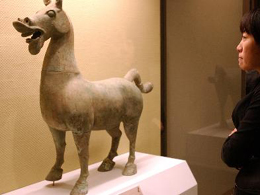
It is common knowledge that China is shaped by 56 ethnic groups,
including the Han people.
But how did all these people come together in history,
eventually sharing the same identity as the Chinese?
Visitors to "Heritages of the Ancient Baiyue Tribes in Guangxi,"
an ongoing exhibition at the National Museum of China in Beijing,
may find some hints to the answer.
Running through June 15, the exhibition displays a total of 135
sets of cultural relics from the provincial museum of south China's
Guangxi Zhuang Autonomous Region.
The exhibits are selected pieces from archaeological findings in
the region between the 1970s and 2005.
Among the most interesting items are jade cups with elegant
cloud patterns, a bronze bucket delicately carved with human
figures in dramatic scenes, a phoenix-shaped bronze lamp, a mask
probably used in witchcraft, a group of three-legged bronze vessels
for cooking or ritual purposes.
These items successfully combined casting technologies from the
North and local, ethnic ideas and aesthetics, said Lan Riyong,
director of Museum of the Guangxi Zhuang Autonomous Region in
Beijing.
"The exhibition is aimed at giving viewers a vivid example of
how ancient peoples interacted with each other some 2,000 years ago
and finally merged into a vast and diversified Chinese nation,"
said Lan.
Also noteworthy are several bronze or clay models of the
two-storey buildings, popular even today in rural Guangxi, and
several bronze swords bearing mysterious motifs on the blades.
A collection of large bronze drums features winged-people in
boats, a design pattern heavily influenced by the Qin and Han
concepts of celestial beings with wings, the existence of souls and
afterlife for humans, explained Hu Xiaojian, a researcher with the
National Museum of China.
In 219 BC, Emperor Qinshihuang, founder of the Qin Dynasty
(221-206 BC), the first centralized, powerful feudal dynasty in
China, sent an army of about 500,000 to the Lingnan Area in today's
Guangxi and Guangdong Province to conquer local tribes.
The army met with fierce resistance from locals in the following
three years.
It was not until a canal was dug in 217 BC to link the
tributaries of Yangtze River and the Lijiang River did the Qin army
maintain a smooth supply of reinforcing units and logistics from
northern China.
In 214 BC, the Qin army defeated local tribes after numerous
tough battles.
The Qin Dynasty soon set up three Juns, or counties, namely
Guilin, Nanhai and Xiangjun, covering today's Guangdong, Guangxi,
and the northern tip of Viet Nam.
Between Qin and Western Han (206 BC-25 AD) dynasties, a Southern
Yue Kingdom (204-111 BC) existed, with former Qin general Zhao Tuo
as its founding father.
But Emperor Wudi of Western Han Dynasty took back most of the
area from the Southern Yue Kings, establishing nine counties.
Since then, the Lingnan area has been a part of the Chinese
nation.
The ancient Baiyue tribes are believed to be the ancestors for a
couple of Chinese ethnic groups now living in Guangdong and
Guangxi, including Zhuang, Shui, Miao, Yao, Yi and Dong ethnic
minorities.
(China Daily April 4, 2006)

